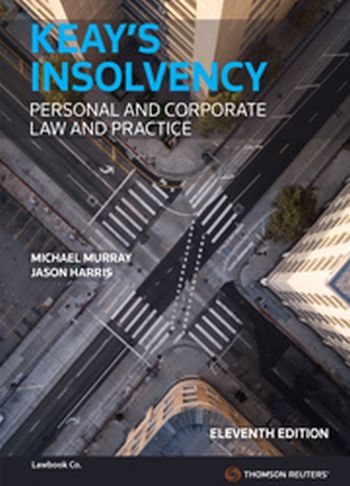Keay's Insolvency: Personal and Corporate Law and Practice 11th ed
ISBN13: 9780455501994
Published: July 2022
Publisher: Thomson Reuters Australia
Country of Publication: Australia
Format: Paperback
Usually despatched in 1 to 3 weeks.
Keay’s Insolvency has become a recognised text on personal and corporate insolvency law and practice in Australia, and it is widely used by practitioners and regularly cited in court. It offers both a detailed explanation of the law, supported by case law and commentary, and of insolvency practice, along with the authors’ critical analysis of the effectiveness and efficiency of the regime and views on its need for reform.
This edition explains Australian insolvency law under the Bankruptcy Act 1966 and the Corporations Act 2001, in light of the substantial case law and practice developments flowing from the changes made by the Insolvency Law Reform Act 2016 (ILRA). Further changes to the law under safe harbour, ‘ipso facto’ and anti-phoenix company reforms, and under debt agreement reforms, and then further reforms again as a consequence of the economic and social impacts of COVID-19, are also explained.
Keay’s Insolvency therefore now covers:
- the application of the ILRA reforms across personal and corporate insolvency
- the safe harbour reforms under s 588GA of the Corporations Act and their 2021 review
- the ‘ipso facto’ reforms of 2018, the anti-phoenix reforms of 2019 and the redesign of Part 5.8A (protection of employee entitlements)
- the restrictions imposed on creditors as a consequence of COVID-19 and the concessions made to debtors, including in relation to safe harbour
- the introduction of Part 5.3B small business restructuring and simplified liquidation
the reforms to debt agreements under the Bankruptcy Act and delayed consideration of a one-year bankruptcy
increased powers and activity of the ATO and of FEG other agencies, and
- the latest case law, including in relation to preferences and set-off
While Keay’s Insolvency continues with the authors’ views on the need for major reform of insolvency law and practice, they explain what they see as initial structural reforms necessary to address significant gaps and deficiencies in the insolvency process. Those studying and practising in insolvency now have an authoritative text covering all current insolvency and restructuring law and practice in Australia. It is now approaching its 30th year of publication with this, its 11th edition.
NEW TO THE ELEVENTH EDITION
- Explains how the significant changes under the ILRA have been applied in relation to practitioner registration and regulation; the conduct of administrations including notice and meeting requirements, remuneration determinations and reviews, rights of creditors, and powers of the court and the regulators
- Continuation of the focus on corporate restructuring law and practice and arrangements outside the context of formal insolvency, explained as a separate discipline, but also in the context of the latest innovative approaches to Pt 5.3A deeds of company arrangement and Pt 5.1 schemes, and the new Part 5.3B restructurings
- Updated and more detailed commentary on the law of insolvent trading trusts, international and cross-border insolvency, tax, employment, and family law
- Updated with the latest PPSA law and practice
- Explains the roles of the courts and of the duties of lawyers acting in insolvency
- Continued emphasis on the legal and regulatory requirements of ASIC, AFSA and ARITA, the Courts’ rules and the ATO and FEG requirements
- Useful tables summarising and explaining the law
- An explanation of the fundamental purposes and aims of insolvency with a robust commentary on the problems with the current regimes and with ideas for change
